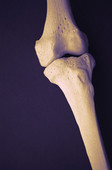Scientists Discover How Osteoarthritis Destroys Cartilage
For sufferers of joint disease, finding could lead to preventive treatments, study says.
|
E-mail this article
Subscribe to news
Printer friendly version
|

(SOURCE: University of Rochester Medical Center, news release, Sept. 2, 2008)
THURSDAY, Sept. 4 (HealthDay News) -- The first direct proof of how osteoarthritis destroys cartilage has been discovered by University of Rochester Medical Center researchers.
They said their finding could lead to preventive treatments for a disease that affects almost 21 million aging Americans and is the leading cause of disability in the United States.
Until now, little was known about the cellular and molecular mechanisms that cause the break down of the cartilage in joints. Previous research suggested that higher levels of signaling protein called beta-catenin were associated with osteoarthritis (OA), but there was no direct evidence to confirm that link.
The University of Rochester Medical Center team genetically engineered mice with high levels of beta-catenin and found the mice lost most of their articular cartilage -- the protective layer that covers the ends of bones within joints. The mice also developed the same bony growths and microfractures that occur in people with OA.
In a companion experiment, the researchers also found much higher-than-normal beta-catenin levels in cartilage cells taken from patients with severe arthritis.
"We have created the first model in a living animal that shows exactly how osteoarthritis causes damage. That, of course, puts us in position to interfere with the processes that contribute to the damage in a new and powerful way," study author Dr. Di Chen, an associate professor in the department of orthopedics, said in a university news release.
The study was published Sept. 2 in the Journal of Bone and Mineral Research.
"The first step was to prove that beta-catenin is central to OA development, and I think we have done that," Chen said. "Now, we are seeking to confirm that mechanical loading and meniscal injury create higher levels of beta-catenin in osteoarthritis joints, and that this and meniscal injury [the meniscus is the sponge-like layer of cartilage between the bones of the knee] create higher levels of beta-catenin in osteoarthritic joints, and that this in turn causes cartilage destruction and too fast differentiation of cartilage into bone."
More information
The Arthritis Foundation has more about osteoarthritis. 
Copyright © 2008 ScoutNews, LLC. All rights reserved. 
HealthDayNews articles are derived from various sources and do not reflect federal policy. healthfinder.gov does not endorse opinions, products, or services that may appear in news stories. For more information on health topics in the news, visit the healthfinder.gov health library.